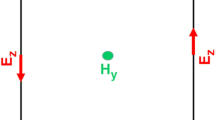Abstract
Due to different sedimentary environments, the realistic formation always presents different electrical anisotropic characteristics. Multicomponent induction logging technology is an efficient method to solve complicated electrical anisotropy problems. However, because of the mathematical complexity, the investigation of unconventional electrical anisotropy in borehole geophysics is still insufficient. Additional situations, such as the classification of electrical anisotropy and the corresponding solution, need to be considered. For convenience, we introduce a universal algorithm to solve arbitrary electrical anisotropic problems. Uniaxial and biaxial anisotropic resistivity media are studied. In addition, the anisotropic dip and azimuth angles are used to further characterize the complex electrical anisotropy conditions. Numerical simulations confirm the robustness of the algorithm, and illustrate the tool responses under different electrical anisotropic situations. It can be concluded that anisotropic dip and azimuth can exert a great influence on triaxial induction logging responses. Some important phenomena can be observed; for example, critical borehole and critical anisotropic dip exist in the rotated uniaxial and biaxial media. Different monotonic rules can be found before and after these critical angles. Cross-coupling magnetic components, Hxy (Hyx) and Hyz (Hzy), are closely related to the anisotropic azimuth. The proposed algorithm can effectively overcome the deficiency of the traditional method and reduce the uncertainties in resistivity interpretation.




















Similar content being viewed by others
References
Anderson, B.I., Barber, T.D. & Gianzero, S.C. 1998, The effect of crossbedding anisotropy on induction tool response: 39 Annual Logging Symposium, SPWLA, SPWLA-1998-B.
Anderson, B. I., & Barber, T. D. (2001). The effect of crossbedding anisotropy on induction tool response. Petrophysics, 42, 137–149.
Chew, W. C. (1995). Waves and Fields in Inhomogeneous Media. IEEE Press.
Eroglu, A., Lee, Y. H., & Lee, J. K. (2011). Dyadic Green’s functions for multi-layered uniaxially anisotropic media with arbitrarily oriented optic axes. IET Microwaves, Antennas & Propagation, 5(15), 1779–1788. https://doi.org/10.1049/iet-map.2010.0499
Georgi, D. T., Schoen, J. H., & Rabinovich, M. (2008). Biaxial anisotropy: Its occurrence and measurement with multicomponent induction tools. Presented at the SPE Annual Technical Conference and Exhibition. https://doi.org/10.2118/114739-MS
Gianzero, S., Kennedy, D., Gao, L., & SanMartin, L. (2002). The response of a triaxial induction sonde in a biaxial anisotropic media. Petrophysics, 43(2), 172–184.
He, Z., Huang, K., Liu, R. C., Guo, C., Jin, Z., & Zhang, L. (2015). A semianalytic solution to the response of a triaxial induction logging tool in a layered biaxial anisotropic formation. Geophysics, 81(1), D71–D82. https://doi.org/10.1190/GEO2015-0105.1
Hu, X., & Fan, Y. (2018). Huber inversion for logging-while-drilling resistivity measurements in high angle and horizontal wells. Geophysics, 83(2), D113–D125. https://doi.org/10.1190/GEO2017-0459.1
Hu, Y., Fang, Y., Wang, D., Zhong, Y., & Liu, Q. H. (2018). Electromagnetic waves in multilayered generalized anisotropic media. IEEE Transactions on Geoscience and Remote Sensing, 99, 1–9. https://doi.org/10.1109/TGRS.2018.2825430
Løseth, L. O., & Ursin, B. (2007). Electromagnetic fields in planarly layered anisotropic media. Geophysical Journal International, 170(1), 44–80. https://doi.org/10.1111/j.1365-246X.2007.03390.x
Meyer, W. H., 1993, Inversion of 2MHz propagation resistivity logs in dipping thin beds: 34th Annual Logging Symposium, SPWLA, SPWLA-1993-BB.
Pardo, D., & Torres-Verdín, C. (2015). Fast 1D inversion of logging-while-drilling resistivity measurements for improved estimation of formation resistivity in high-angle and horizontal wells. Geophysics, 80(2), 111–124. https://doi.org/10.1190/geo2014-0211.1
Pettis, G. F. (2008). Hertzian Dipoles and Microstrip Circuits on Arbitrarily Oriented Biaxially Anisotropic Media. Syracuse University.
Rathod, H. T., Venkatesudu, B., & Nagaraja, K. V. (2007). On the application of two Gauss–Legendre quadrature rules for composite numerical integration over a tetrahedral region. Applied Mathematics and Computation, 189(1), 131–162. https://doi.org/10.1016/j.amc.2006.11.055
Sun, K., C. Morriss, J. Rasmus, K. Ito, S. Asif, R. Griffiths, D. Maggs, D. Omeragic, S. Crary, and A. Abubakar, 2014, Automated resistivity inversion for efficient formation evaluation in high-angle and horizontal wells: 55th Annual Logging Symposium, SPWLA, SPWLA-2014-GG.
Wang, H., Barber, T.D., Morriss, C., Rosthal, R. A., Chen, K.-C., Smits, J. W., Tumbiolo, G., 2006, Triaxial induction logging: Theory, modeling, inversion and interpretation. Society of Petroleum Engineers: Presented at the SPE China International Oil & Gas Conference and Exhibition, doi:https://doi.org/10.2118/103897-MS.
Wang, G.L., Barber, T., Wu, P., Allen, D., & Abubakar, A., 2015, A new model for understanding triaxial induction response in dipping crossbedded formations: 56th SPWLA Annual Logging Symposium, SPWLA-2015-SS.
Wang, G. L., Barber, T., Wu, P., Allen, D., & Abubakar, A. (2017). Fast inversion of triaxial induction data in dipping crossbedded formations. Geophysics, 82(2), D31–D45. https://doi.org/10.1190/GEO2015-0610.1
Yuan, N., Nie, X. C., Liu, R., & Qiu, C. W. (2010). Simulation of full responses of a triaxial induction tool in a homogeneous biaxial anisotropic formation. Geophysics, 75(2), E101–E114. https://doi.org/10.1190/1.3336959
Zhong, L., Li, J., Bhardwaj, A., Shen, L. C., & Liu, R. C. (2008). Computation of triaxial induction logging tools in layered anisotropic dipping formations. IEEE Transactions on Geoscience and Remote Sensing, 46, 1148–1163. https://doi.org/10.1109/TGRS.2008.915749
Acknowledgements
This work was supported by the Research Foundation of China University of Petroleum-Beijing at Karamay, XQZX20200007, the Xinjiang Natural Science Foundation, 2020D01B63, and Xinjiang Scientific research projects in Colleges and Universities, XJEDU2021Y052. The authors would also like to acknowledge their colleagues at the faculty of petroleum in China University of Petroleum-Beijing at Karamay.
Funding
This work was supported by the Research Foundation of China University of Petroleum-Beijing at Karamay, XQZX20200007, Xinjiang Natural Science Foundation, 2020D01B63, and Xinjiang Scientific research projects in Colleges and Universities, XJEDU2021Y052.
Author information
Authors and Affiliations
Corresponding author
Ethics declarations
Conflict of interest
The authors declare that they have no competing interests.
Additional information
Publisher's Note
Springer Nature remains neutral with regard to jurisdictional claims in published maps and institutional affiliations.
Rights and permissions
Springer Nature or its licensor (e.g. a society or other partner) holds exclusive rights to this article under a publishing agreement with the author(s) or other rightsholder(s); author self-archiving of the accepted manuscript version of this article is solely governed by the terms of such publishing agreement and applicable law.
About this article
Cite this article
Hu, X., Feng, N. Multicomponent Induction Logging Responses in Layered Uniaxial and Biaxial Anisotropic Media. Pure Appl. Geophys. 179, 4445–4463 (2022). https://doi.org/10.1007/s00024-022-03174-x
Received:
Revised:
Accepted:
Published:
Issue Date:
DOI: https://doi.org/10.1007/s00024-022-03174-x



